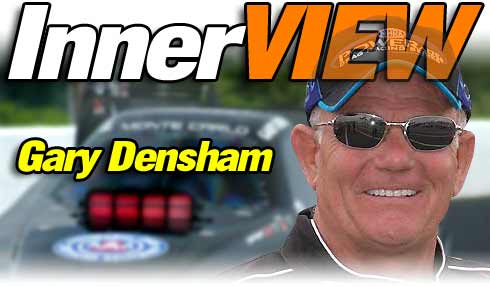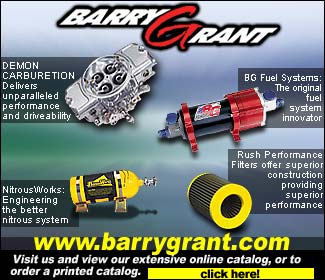| 
Words and photos by Ian
Tocher
8/8/05
 ary
Densham, who for over a quarter of a century was a high school
auto shop teacher in Bellflower, Calif., epitomizes the hard-cord,
never-say-die independent Southern California fuel Funny Car
racer. Originally, Densham made his bones in the late 1960s
with an A/Gas Supercharged roadster, the Densham-Plueger-Bilby
8.5- and 8.6-second entry, and then graduated in 1970 to Funny
Car with a Ford Pinto that he ran in partnership with Fuel
Altered driver Bob Walker. ary
Densham, who for over a quarter of a century was a high school
auto shop teacher in Bellflower, Calif., epitomizes the hard-cord,
never-say-die independent Southern California fuel Funny Car
racer. Originally, Densham made his bones in the late 1960s
with an A/Gas Supercharged roadster, the Densham-Plueger-Bilby
8.5- and 8.6-second entry, and then graduated in 1970 to Funny
Car with a Ford Pinto that he ran in partnership with Fuel
Altered driver Bob Walker.
Two years later, Densham introduced what would be the first
of nearly two decades of “Teacher’s Pet”
Funny Cars. He made his NHRA national event debut at the 1974
ADVERTISEMENT
 |
Winternationals with a ’72 Barracuda, but failed to
qualify with it despite running a career best 6.66. He plugged
on and on, running primarily at Orange County and Irwindale,
as well as West Coast-based NHRA and AHRA events.
The big moment for Densham came in March 2001 when long-time
pal and competitor John Force signed him up as the third driver
on his Castrol GTX race team. He scored his first NHRA national
event win at Memphis in 2001 and went on to record seven more
association Funny Car titles through the 2005 season. In the
year previous, Densham pulled a rarity when he won both the
U.S. Nationals Funny Car title and its companion feature,
the Skoal Showdown.
Last year, the 58-year-old Densham’s tenure with Force
ended and he currently is back with the Racebrick Monte Carlo,
which is spurred on by tune up pros Greg Amaral and Rob Flynn.
Early this summer, Densham spoke with DRO about the changes
and challenges of running his own team, as well as his views
on NHRA and how it addresses various issues.
 You’ve
gone from four years of driving and winning for perhaps the
strongest team in drag racing, and now you’re back to
fielding your own team and struggling sometimes just to qualify.
How does that feel when you get to the track? You’ve
gone from four years of driving and winning for perhaps the
strongest team in drag racing, and now you’re back to
fielding your own team and struggling sometimes just to qualify.
How does that feel when you get to the track?
DEnsham: Well, obviously,
when you race with John Force Racing you’ve got the
best of everything. Every part is brand new, everything is
perfect, you’ve got a hugely experienced crew and a
lot of people working with you, including Jimmy Prock, who’s
just a magician at what he’s capable of doing. That
gives you, as a driver, a lot of confidence, but it’s
still great to be back on my own. What we really need is a
big, ol’ bucket of money. That’s the bottom line
and we don’t have that right now.
 What
does it realistically cost to race a Fuel Flopper at this
level? What
does it realistically cost to race a Fuel Flopper at this
level?
Densham: (Laughs) Do you mean what you need,
or what we do it on? Seriously, that was one thing that I
did get to learn a lot about being over there with John and
watching what they do. John budgets two-and-a-half-million
dollars a year to each one of those cars, but that takes into
consideration beautiful race rigs, beautiful shops in California
and Indy, big overhead with crew salaries and office personnel
and all sorts of other stuff.
Realistically, to run the car and go after the championship,
you probably need about $1.8 million a year…. Even though
they (Force) have virtually an unlimited budget over there,
they’re relatively conservative with their parts as
far as using them until they’re used up. If I was trying
to save money here I probably couldn’t cut costs by
more than 10 percent on the actual running of the car.

|
